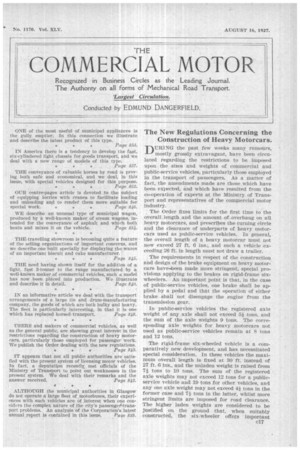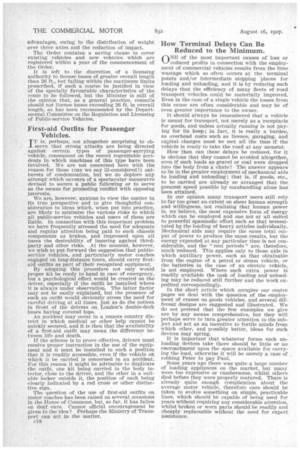The New Regulations Concerning the Construction of Heavy Motorcars.
Page 39

Page 40

If you've noticed an error in this article please click here to report it so we can fix it.
-FILMING the past few weeks many rumours, -" mostly grossly extravagant, have been circulated regarding the restrictions to be imposed upon the sizes and weights of commercial and public-service vehicles, particularly those employed in the transport of passengers. As a matter of fact, the amendments made are those which have been expected, and which have resulted from the co-operation of experts at the Ministry of Transport and representatives of the commercial motor industry.
The Order fixes limits for the first time to the overall length and the amount of overhang on all heavy motorcars, and prescribes the turning circle and the clearance of underparts of heavy motorcars used as public-service vehicles. In general, the overall length of a heavy motorcar must not now exceed 27 ft. 6 ins.-, and such a vehicle exceeding 26 ft. in length must not draw a trailer.
The requirements in respect of the construction and design of the brake equipment on heavy motorcars have-been made more stringent, special provisions applying to the brakes on rigid-frame sixwheelers. An important point is that, in the case of public-service vehicles, one brake shall be applied by a pedal and that the operation of either brake shall not disengage the _engine from the transmission gear.
In public-service vehicles the registered axle weight of any axle shall not exceed 15i tons, and the sum of the axle weights 9 tons. The corresponding axle weights for heavy motorcars not used as public-service vehicles remain at 8 tons and 12 tons.
The rigid-frame six-wheeled vehicle is a comparatively new development, and has necessitated special consideration. In these vehicles the maximum overall length is fixed at 30 ft. instead of 27 ft. 6 ins., and the unladen weight is raised from 7f tons to 10 tons. The sum of the registered axle weights may not exceed 12 tons for a publicservice vehicle and 19 tons for other vehicles, and any one axle weight may not exceed 4i tons in the former case and 7i tons in the latter, whilst more stringent limits are imposed for road clearance. The higher laden weights are considered to be justified oa the ground that, when suitably constructed, the six-wheeler offers important advantages, owing to the distribution of. weight over three axles and the reduction of impact.
The Order contains a saving clause to cover existing vehicles and new vehicles which are registered within a year of the commencement of the Order.
It is left to the discretion of a licensing authority to license buses of greater overall length than 26 ft., but falling within the maximum 'limits prescribed, if such a course be justified. in view of the specially favourable characteristics of the route to be followed, but the Minister is still of the opinion that, as a general practice, councils should not license buses exceeding 26 ft. in overall length, as has been recommended by the Departmental Committee on the Regulation and Licensing of Public-service Vehicles.
First-aid Outfits for Passenger Vehicles.
IT is, perhaps, not altogether surprising to observe that strong attacks are being directed against certain types of passenger-carrying vehicle, consequent on the recent regrettable accidents in which machines of this type have been Involved. We are not concerned here with the reason for these (can we say ill-considered?) outbursts of condemnation, but we do deplore any attempt which savours of a spectacular mameuvre devised to secure a public following or to serve as the means for promoting conflict with opposing interests.
We are, however, anxious to view the matter in Its true perspective and to give thoughtful consideration to ideas which, when put into practice, are likely to minimize the various risks to which all public-service vehicles and users of them are liable. In connection with this important problem we have frequently stressed the need for adequate and regular attention being paid to such chassis components as brakes, and impressed upon all users the desirability of insuring against thirdparty and other risks. At the moment, however, we wish to put forward the suggestion that public-. service vehicles, and particularly motor coaches engaged on long-distance tours, should carry firstaid outfits as part of their recognized equipment. • By adopting this procedure not only would proper kit be ready to hand in case of emergency, but a psychological effect would be created on the driver, especially if the Outfit be installed where it is always under observation. The latter factor may not be easily explained, but the presence of such an outfit would obviously stress the need for careful driving at all times, just as do the notices in front of the drivers on London's double-deck buses having covered tops.
An accident may occur in a remote country district in which medical or other help cannot be quickly secured, and it is then that the availability of a first-aid outfit may mean the difference between life and death.
If the scheme is to prove effective, drivers must receive proper instruction in the use of the equipment and it must be installed in such a position that it is readily accessible, even if the vehicle on which it be carried is concerned in an accident. For this reason it might be advisable to duplicate the outfit, one kit being carried in the body interior, close to the driver, and the other in a suitable locker outside it, the position of each being clearly indicated by a red cross or other distinctive sign..
The question of the use of first-aid outfits on motor coaches has been raised on several occasions in the House of Commons, but. so far, it has fallen on deaf ears. Cannot official encouragement be given to the idea? Perhaps the Ministry, of Transport can act in the matter.
c18
How Terminal Delays Can Be Reduced to the Minimum.
ONE of the most important causes of loss or reduced profits in connection with the employment of commercial vehicles results from the time . wastage which so often occurs at the terminal points and/or intermediate stopping places for loading and unloading, and it is by reducing such delays that the efficiency of many fleets of road transport vehicles could be materially improved. Even in the ease of a single vehicle the losses from this cause are often considerable and may be of even greater Importance to the owner.
It should always be remembered that a vehicle _ is meant for transport, not merely, as a receptacle for goods, and unless actually running is not paying for its keep ; in fact, it is really a burden, as overhead costs such as licence, garaging, and capital charges must be met • all the time if the vehicle is ready to take the road at any moment.
How then can these delays be reduced, for it is obvious that they cannot be avoided altogether, even if such loads as gravel or coal were dropped into the body from a chute? The answer appears to lie in the greater employment of mechanical aids to loading and unloading; that is, if goods, etc., to be carried are already so arranged that the greatest speed possible by manhandling •alone has been attained.
In our opinion many transport users still. rely to far too great an extent on sheer human strength and willingness, not realizing that human power is, we believe, the most expensive form of energy which can be employed and one not at all suited to powerful 'spasmodic effort such as that necessitated by the loading of heavy articles individually. Mechanical aids may require the same total output of power to produce the same results, but the energy expended at any particular time is not considerable, and the "rest periods" are, therefore, much reduced. This applies only to those aids in which auxiliary power, such as that obtainable from the engine of a petrol or steam vehicle,. or the batteries in the case of an electric vehicle, is not emplOyed. Where such extra power is readily available the task of loading and unloading may be reduced still further and the work expedited correspondingly.
In the short article which occupies our centre pages we deal with the question of the employment of cranes on goods vehicles, and several different designs are suggested and illustrated.. We do not pretend that the few examples we give are by any means comprehensive, but they will perhaps serve to turn greater attention to the subject and act as an incentive to fertile minds from which other, and possibly better, ideas for such devices may spring.
It is important that whatever forms such unloading devices take there should be little or no encroachment upon the space available for carrying the load, otherwise it will be merely a case of _ robbing Peter to pay Paul.
Some years ago there was quite a large number of loading appliances on the market, but many were too expensive or cumbersome, whilst others died before they were properly matured. There is already quite enough complication about the average motor. vehicle, therefore care should be taken to evolve something on simple, practicable lines, which should be capable of being used for years without requiring any considerable attention, whilst broken or worn parts should be readily and cheaply replaceable without the need for expert assistance.












































































































